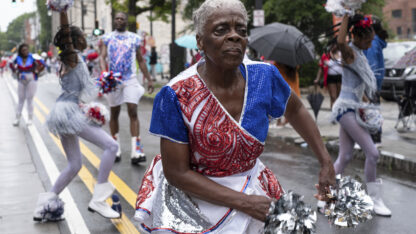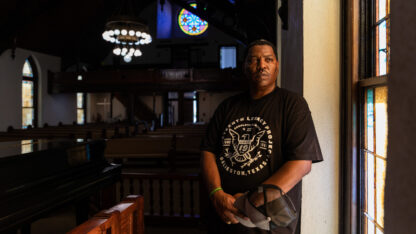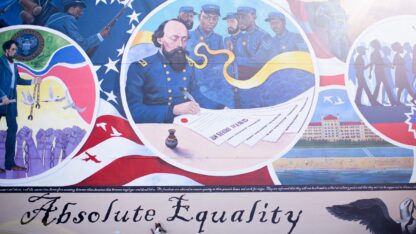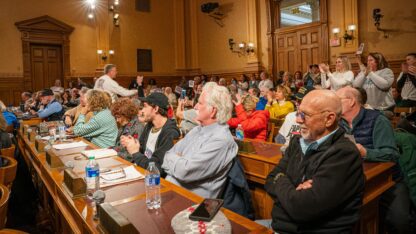On a cool spring day, Fredrika Newton — the widow of Black Panther co-founder, Huey P. Newton — stands next to a bronze bust of her late husband. It’s situated in a wide, landscaped median in the west end of Oakland that the Panthers called home.
“The Black Panther Party is an American story, and that’s the job of the National Park Service is to tell the American story,” Newton says.
Once upon a time, former FBI director J. Edgar Hoover called the Panthers the “greatest threat to internal security.”
A half-century later, as perspectives have mellowed, the Huey Newton statue could eventually become part of a National Historical Park. Other possible stops: the former Panther party headquarters, locations of the group’s free medical clinics and free children’s breakfast program, and the spot where Newton was murdered. All of it may one day be patrolled by a park ranger in a traditional NPS flat hat.
The exploration of a Black Panther historical site is just one example of how the National Park Service is striving to incorporate more Black history into its storytelling about America. The Park Service has a growing network of national historic sites across the Deep South that recognize achievements and atrocities during the civil rights movement. But the idea of a Black Panther Party National Historical Park is singularly controversial. In 2017, the Park Service had to cancel the idea after police groups complained to President Donald Trump that the nation was commemorating a violent separatist group.
“It’s one of the most misunderstood legacies of this party,” Fredrika Newton says. “It wasn’t hate. It wasn’t a nationalist organization. It was not a racist organization. Our mission was to fight oppression for all oppressed people.”
But with a Democrat in the White House, the project is back under study.
“I’m encouraged,” she says. “There is a hunger for knowledge of what it was that the Black Panther Party did.”
There are currently about 40 sites in the park system referred to as “African-American experience sites.” These include the Brown v. Board of Education National Historical Park in Kansas, the Little Rock Central High School National Historic Site in Arkansas, the Birmingham Civil Rights National Monument in Alabama, the Selma to Montgomery National Historic Trail, and the Medgar and Myrlie Evers Home National Monument in Jackson, Miss. That’s the house where the NAACP’s state field secretary was murdered in 1963.
It may come as a surprise that the National Park Service — which gave us “America’s Best Idea,” from the majestic landscapes of Yellowstone to the Grand Canyon — is highlighting chapters of modern history that some Americans are ashamed of.
“Now’s the time,” says Alan Spears, senior director for cultural resources at the National Parks Conservation Association, a non-profit that advocates for the National Parks System. “We can quote Charlie Parker, now’s the time to really begin addressing these stories, looking at them in a candid way.
“I think there’s a great deal of pain out there,” Spears adds, “and it’s the pain that comes from having unresolved history and history that’s been deliberately overlooked and neglected.”
Even more African-American experience sites are being considered.
In addition to a possible Black Panther park, NPS is studying a location that remembers the 1964 murders of three civil rights workers — James Chaney, Andrew Goodman, and Michael Schwerner — in Mississippi, and a location that spotlights the 1955 lynching of Emmett Till, a 14-year-old Black youth accused of offending a white woman in Mississippi. New national parks are established either through an act of Congress or a presidential proclamation.
Alan Spears, who is Black, says if these new historic designations become a reality, they’ll create opportunities for visitors to have conversations about race.
“And sometimes that makes them controversial to some people, but critical to folks like myself,” he says, “who think that we gain much more than we lose by taking a direct look and a candid look at our history and our past.”
As Spears says, some of this history is unresolved.
A case in point: the National Park Service erected a sign beside the highway outside of Anniston, Ala., on the spot where in 1961 white segregationists fire-bombed a bus that was carrying the interracial Freedom Riders through the Deep South to protest segregated bus station waiting rooms. Earlier this year, a car rammed the NPS sign and sprayed mud all over it.
Yet, there’s more reconciliation than resentment these days.
Charles Person, now 78, was one of the original Freedom Riders, and he is urging the Park Service to commemorate their ride. He remembers a trip he took back to Anniston, and how the town is now promoting the official Freedom Riders National Monument.
“When we came there, a gentleman showed up and he was a grandson of one of the klansmen,” Person remembers. “And he apologized for the beating they gave, for setting the bus on fire.”
During that trip, Person continues, “We were so amazed at the things the town was trying to do. I would live there now. I mean, that’s how much the attitudes of the people have changed.”
The National Park Service’s Southern Regional Office in Atlanta is studying the designation of future Mississippi civil rights sites, as well as Atlanta’s West Hunter Street Baptist Church, home church of the Rev. Ralph Abernathy, the civil rights leader and close friend of King.
“When we talk about the story of America, its founding, its development and its reality today, many of those stories are noble, but they are sometimes shameful and sad,” says NPS Atlanta spokesperson Saudia Muwwakkil. “But, collectively, they define who we are and who we can be.”
One of the first civil rights sites in the NPS network was the Martin Luther King, Jr. National Historical Park, established in 1980. It’s grown into a major tourist attraction in Atlanta. Visitors can see his birth home, his church, the sprawling visitor center and the World Peace Rose Garden.
But this is not just a place to learn about the life and times of MLK. For the people of Atlanta, the King park continues to connect them to the spirit of non-violence and the struggle for racial justice.
“When Mandela passed away people came here,” says Marty Smith, interpretative ranger at the King Historical Park. “When Congressman John Lewis passed away, people came here. George Floyd, people came here. So that just shows you how powerful this site is.”
The night that Barack Obama was elected 44th president in 2008, Smith says he walked out onto the grounds and encountered hundreds of people who were drawn to the King historical park to celebrate. That, he says, is living history.

9(MDAxODM0MDY4MDEyMTY4NDA3MzI3YjkzMw004))








